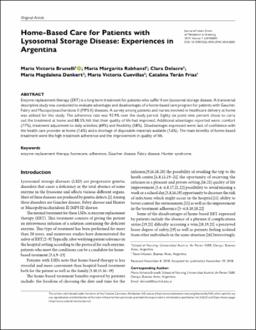| dc.contributor.author | Brunelli, Maria Victoria. | |
| dc.contributor.author | Rabhansl, Maria. | |
| dc.contributor.author | Delacre, Clara. | |
| dc.contributor.author | Dankert, Maria. | |
| dc.contributor.author | Cuevillas, Maria. | |
| dc.contributor.author | Frias, Catalina | |
| dc.date.accessioned | 2020-09-23T20:38:11Z | |
| dc.date.available | 2020-09-23T20:38:11Z | |
| dc.date.issued | 2019-07-01 | |
| dc.identifier.citation | J. inborn errors metab. screen. vol.7 Porto Alegre 2019 Epub Mar 07, 2019 | en_US |
| dc.identifier.issn | 2326-4594 | |
| dc.identifier.uri | https://riu.austral.edu.ar/handle/123456789/954 | |
| dc.description.abstract | ABSTRACT
Enzyme replacement therapy (ERT) is a long term treatment for patients who suffer from lysosomal storage disease. A transversal
descriptive study was conducted to evaluate advantages and disadvantages of a home-based care program for patients with Gaucher,
Fabry and Mucopolysaccharidosis II (MPS II) diseases. A survey among patients and nurses involved in healthcare delivery at home
was utilized for this study. The adherence rate was 92.9% over the study period. Eighty six point nine percent chose to carry
out the treatment at home and 88.5% felt that their quality of life had improved. Additional advantages reported were: comfort
(77%), treatment adjustment to daily activities (69%) and flexibility (58%). Disadvantages expressed were: lack of confidence with
the health care provider at home (1.6%) and a shortage of disposable materials available (1.6%). The main benefits of home-based
treatment were the high treatment adherence and the improvement in quality of life. | en_US |
| dc.language.iso | en | en_US |
| dc.publisher | Latin American Society Inborn Errors and Neonatal Screening | en_US |
| dc.subject | Enzyme replacement therapy | en_US |
| dc.subject | Homecare | en_US |
| dc.subject | Adherence | en_US |
| dc.subject | Gaucher disease | en_US |
| dc.subject | Fabry disease | en_US |
| dc.subject | Hunter syndrome | en_US |
| dc.title | Home-Based Care for Patients with Lysosomal Storage Disease: Experiences in Argentina | en_US |
| dc.type | Article | en_US |


